Newcastle Disease Viruses
Published: December 20, 2013
By: Abdelaziz Abdelfatah Abdelmotii Ebrahim (Avian Poultry Consultant of Middle East)
- This is septicemic deadly virus of poultry which affect chicken " especially younger ones" - Turkey – quills – pigeon and rarely duck.
- This viruses is belonged to Family called paramoxy viruses sero type I ( A P M v-1)
- Paramoxy viruses classified into:
A- paramoxy virus ( pro type . ND viruses )
B- paramoxy virus ( respiratory form )
C- Morbili virus ( measles form )
all paramoxy virus consists from:
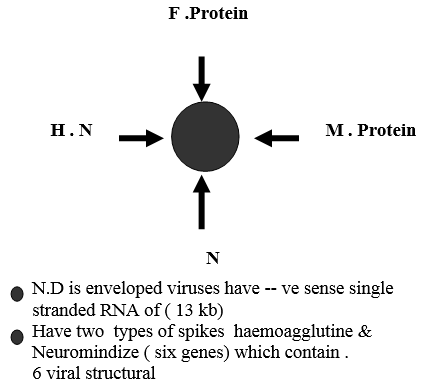
- The viral (F) .protein brings about fusion between the viral membrane and the cell membrane so the viral genes enters the cell and replicate in it and during replication N.D particles are produced with a precursors glycoprotein ( F) that has to be cleaved to F 1 , F2 glycoprotein.
- in case of Avian influenze , the penetration occur by areceptor mediated endocytocsis mechanizms which could be affected by the affect of essential oil on the attachment mechanizm of the viruses by the effecting the configuration of the heamagglutine protein.
Newcastle disease virus virulence is measured by
- The virus has an intra cebral pathogenicity index ( ICPI) in day old chick (gallus gallus) of (0.7) or greater.
- multiple basic aminoacids either directly or by deduction at the C . terminus of the F2 protein so the virus considered as septicemic deadly viruses.
A - Classification of the virus acc to its virulence into
1- lentogenic strain
- low in virulence
2- mesogenic strain
- moderate in its virulence as (komorove & Roakin)
3- velogenic strain ( Doyls form & Roakin )
- very virulence as (GBtexas & Herts)
B – according To Tissue morphizm
- neurotropic viruses
- pneumotropic viruses
- vesrotropic viruses
- panotropic viruses
C- acc to name :
- Doyl's form (entiric form )
- Beach form
- Beate detos form
- Hitchner form
- Asymptomatic form
General Clinical signs of N . D viruses infection differs according to
A- immunostatus of bird at time of exposure .
B- the age of the flock Young birds are more affected than aged ones .
C- the degree of exposure of flock to the virus
D – The General healthy condition of the flock at time of exposure as appearance in case of mycotoxicosis .
The clinical signs:
1- unusual quietness of birds and the birds huddle with each other ( 24 hrs ) before the clinical signs become evident especially at early morning.
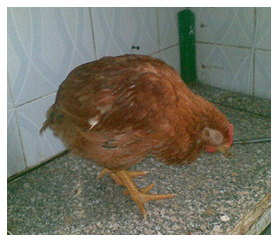
Copy rights (dr . abdelaziz ( photo 1)
2- appearance of sudden respiratory manifestation ( rating sound )
3- feed and water intake is decreased by increasing severity which reach to its half amount than normal ( normally broiler birds eat about 150 gm per a day at 30 day which rich to 65 gm peraday in case of N.D infection .
4- appearance of watery greenish dirrhaee and in some cases bloody dirrhaee
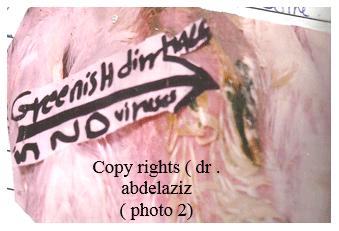
5- coughing , gasping and rating sound which may appears incase of the in the mesogenic form due to the appearance of the neuraminidase enzymes and this material decrease viscosity of the liquid which appears in the epithelial tissue of the respiratory system which leads to opening of receptors and going of this liquid downly to lung.
6- in neurological form appearance of early neurological signs as the tortcolitis ( star gasping) which affect the cerebillium and brain stem producing multi focal glial nodules and necrosis .

Copy rights (dr . abdelaziz ( photo 3)
7- appearance of spasmodic paralysis of Mm .
8- appearance of perching reflex as absence of nerves reflex of the toe legs when putten on finger ( but in normal condition when we put of legs on our finger they will catch down in opposite direction to finger.
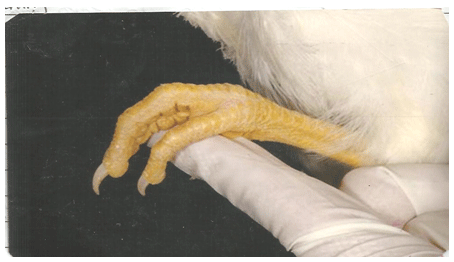
9- appearance of lamness ( relactant to stand or move and appearance of complete paralysis of legs which occur as drop of first wing then 2nd wing beside the incoordination of movement of flock and this called ( dragging of legs).

10- with increase of severity of virus infection and appearance of viramic stage the mortility is increased which reach to high number then stable at the high level in the second day then decline gradually and feed and water increase again and birds scatter again in the farm and respiratory manifestion will decreased again .
- and this curve take about 8 days from its beginning but in case of avian flu the curve of mortility is very high and increase to its double every hours and not ended but the curve of mortility of N.D is ended if the N . D is appears only without any secondary bacterial infection or any viruses infection accompanied .
11- in peracute form ( asymptomatic form appears as many poultry dead from N. D viruses without symptoms and this occur if the birds has higher degree of immunity against the viruses.
( in layers )
- Sudden drop in egg production reach to zero and may lasts for 4-8 weeks.
- Affect on egg quality egg" shell discoloration which considered as one of the first signs of N.D include the reproductive tract of the breeders hen and this sign more appear in brown egg layers . and if the infection is severe the shell become fragile and abnormalities occur in shape size and after signs of N.D disappear the egg production is decreased also for about 4-8 weeks later.
( P.M lesions )
- N .D viruses leads to profuse bleeding as it leads to analysis of R.B.C s .
- appearance of pin point necrotic focii scattered on epidural fat of the leg muscles
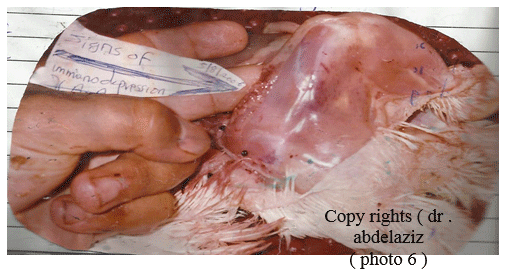
3. severe viramea which leads to bloody appearance of the musculture of the bird Mm and the bird takes (feverished appearance)

4. bleeding into the tracheal mucosa ( hommorragic trachitis as in case of acute form of N . D viruses
5. appearance of pink swollen eye and swollen eye lids with abnormal fluid and faschial oedmae appearance – foamy nasal discharge and accumulation of liquid in trachea .
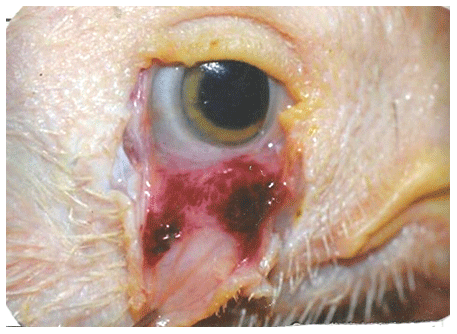
6. lung is congested and appearance of cloudy air sac and exudates present on lung and wipe pipe and acute inflammation of air passages and this called trypling air sacs which called the pneumonia

7. appearance of profuse intestinal and muscular himmorrage called the viramea and appearances of pin point hemorrhagic ulcers called ( Doyls form ) which scattered through the intestinal tract and when this lesion appears confirm that the viruses present in the farm for about 4 : 7 days and this is important in using the emergency vaccination to be of value or not .
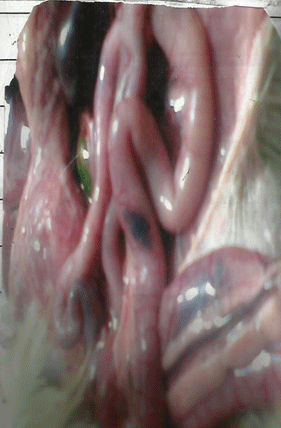
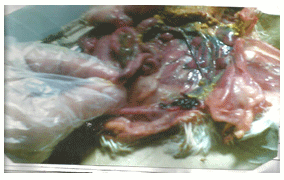
8- appearance of bluish & reddish necrotic raised area at the lymphoid tissue especially blind sac (cecaltonsils)
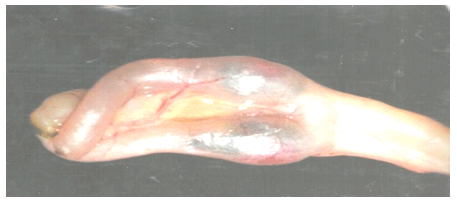
9- appearance of homorrhage on the tips of gizzard and around the surface .
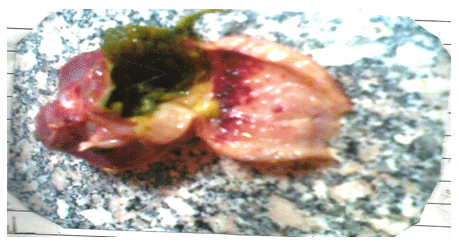
10- appearance of the petchal hommorrhage on the sub pleral fat and heart fat.
11- clocal lesion: Appearance of multiple randomly distrubited well demarcated hommorragic erosions and ulcers and this ulcers present on the mucosa of cloacae with overlying fibrin accumulation .
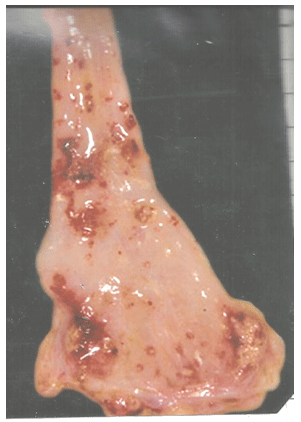
To differentiate the fibrin from digestea by washing the lesion the digesta go out but fibrin is still appears.
Lesion in layers:
- Appearance of necrotic foccii on ova.
- Hommorrage on the ova .
- Shelless egg .
- Colour of eggs is changed especially in brown egg breeds which turned to colourless eggs .

Diagnosis of the virus:
1- isolation and identification of the virus.
(a) samples taking from infected flock.
- take the swabs from trachea ( 10 sample) and 10 swabs from clocae at age of 22 – 28 days of age for PCR.
- taking of blood samples from the jugular vien for serology and H.I Test which is used for antibody number against N.D viruses infection (ANON 1971)
- molecular Basis of viral virulence (Rott and klent) it is possible to use the nucleotide sequencing technique to asses whether or not an isolate has the genetic make up to be highly pathogenic for poultry( Collins 1993 )
- according the HI. test the minimum protection level is mean antibody an of log 20 ( anon 1971) (schmit 1955 )
- studied the relationship of HI. titrc and the protection capacity as HI titre up to 16 failed to resist the challenge infection adequate antipathy (HI) titre of 23 or greater which is the minimum standard to give protection to N.D viruses for birds less than (18 w) and (25) or greater for birds above 48 weeks or older.
Epidemiological group meaning
It is a group of bird is deemed to the same epidemiological group if the following criteria are present as:
A- All birds in the group are vaccinated at the same day.
B- all birds in the group were vaccinated using the same vaccine (same lot / batch no)
C – all birds in the group are of the same age.
D – all birds in the group are of the same spp.
E– biosecurity measured are the same.
Immunity and vaccination against the N. D virus:
A- maternal antibody of N . D viruses
- Chicks from vaccinated parent Stock contained high level of maternally derived antibody which ranged from 285.51 – 289.43) at day old and then degrade gradually below protection level within 15- 20 days after hatching and maternal derived antibody decline about half every 5 days ( Allan etal 1978) as 2 fold decay in maternally derived antibody every (5) days.
- Maternal antibody neutralize the introduced vaccine antigen rendering the vaccine ineffective ( awang et al 1992) immunoresponse was nil at high titre of maternal antibody .
B- humeral Immuroresponse against N . D ( I9M & 19 G)
Maternal antibody neutralize the introduced vaccine . antigen rending the vaccine ineffective ( awanget el 19) Immunoresponse wall be nil at high titre of maternal antibody.
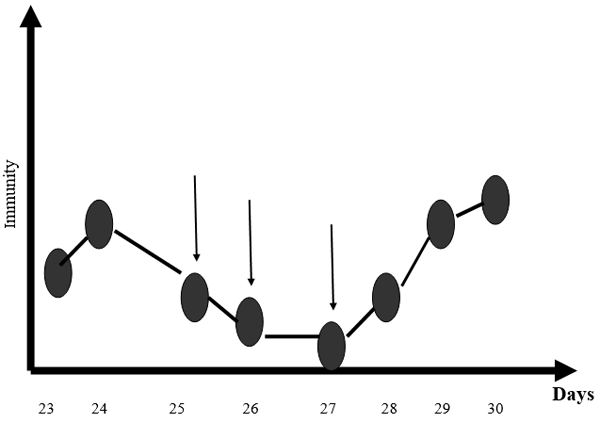
This curve refers to the normal declination of the broiler bird immunity at the age from 25 until 27 day and then go normally to rise from day 28 and this period is very dangerous in the virus infection
Blockage mechanism phenomanah of Newcastle virus
This phenomanah characteristic to N. D viruses as appearance of the competition between the field viruses of N.D and the adapted viruses of the vaccine which used against N. D
Once one of them reach to the target cells in the receptors specialized for N . D will block it and prevent the other virus to enter.
This phenomanah is useful in making emergency vaccination against N . D but this occur under certain condition as.
When the virus of vaccine enter the cells at first before the filed virus the birds will survive and the field virus fail to be pathogenic and appears of good immune system .
But when the opposite occur and field virus enter the cells befor the virus of vaccine so the bird will dead .
And this depends up on the days of infection and the delay of diagnosis .
SO
Emergency vaccination of N .D is useless as incubation period reach from ( 1-3 days) but under stress and environmental problems and appearance of mycotoxin in feed or other stre ssfull condition the immune system of the bird will be weak and the infection takes only 24 hrs to appears.
virus in when present in the intestinal tract or in respiratory tract is very weak and emergency vaccination will be usefull but once enter the blood and go to the viramic stage ( which takes 4 days ) the emergency vaccnation will make the so called ( virus challange ) and will be deadly to birds.
SO
From our field experience if you have a good common sense in the first diagnosis of N.D by clinical signs and Hi test & serology and isolation through the first 24 hrs the vaccinator is will be useful .
But if you delayed in diagnosis of the case and appearance of decreasing of feed intake and water and appearance of Respirotory manifestation and greenish dirrhaee .
SO
The vaccination is forbidden .
SO
How to deal with the case affected by N. D viruses and we delayed in its diagnosis :
You must let the viruses to take its severity period photo and then the bird will recovery from itself and you must in this period concern on using:
1- liver and kidney support derivatives .
2- giving of immuostimulator drugs to bird.
3- good hygenic ventilation control .
You must take care from the using of the antibiotics & injection ( espercilly in the respiratory manifestion which appears as atrap for the farmers and veterinarian .
From our expereience we spray on birds piperment oil and ecupltus derivatives and iodine prepartion at night to decrease the respiratory manifestion problems and to decrease the incidence of enterance of other avian ( flu & IB) in affected area with N. D infection period .
Vaccination control:
Each vaccine againist N . D should contain not less than (106 EID / ml)
ICPI

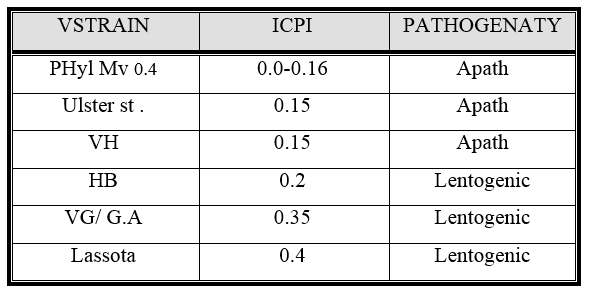
Type of vaccine
Live vaccine:
A- lentognic form
each vaccine should not contain less than (106 EIDso ml)
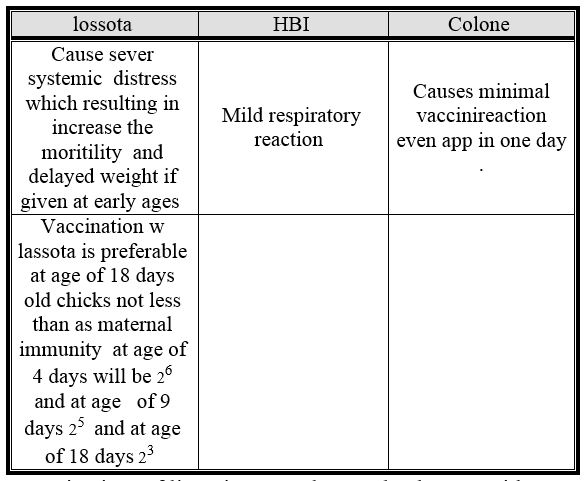
Injection of live viruses as lassota leads to a wide range Of affection in the flock as
1- high antibody
2- stress response
3- neutralization (antibody free)
B- mesogenic form :
1- Using of komorove which used as awing stab a administration .
2- You must give good and sufficient primary dose of N. D before using of komorove by ocular technique by sufficient time . to take good result from using of komorove but if the primary vaccination . has been failed and we use komorove which gives sever post vaccination reaction and sever range of bad effect .
3- mesogenic strain ( is preferable to not applied before 10-12 weeks )
2- killed ( inactivated vaccine )
(Good in decreasing of susceptibility of birds to N. D viruses .
( A) When injected sub/cut or intramuscular work immediately but reach to its peak of action after is days of injection.
( B) it is preferable . to vaccinate both live and killed vaccine to reach the so called hyper immunization procedure .
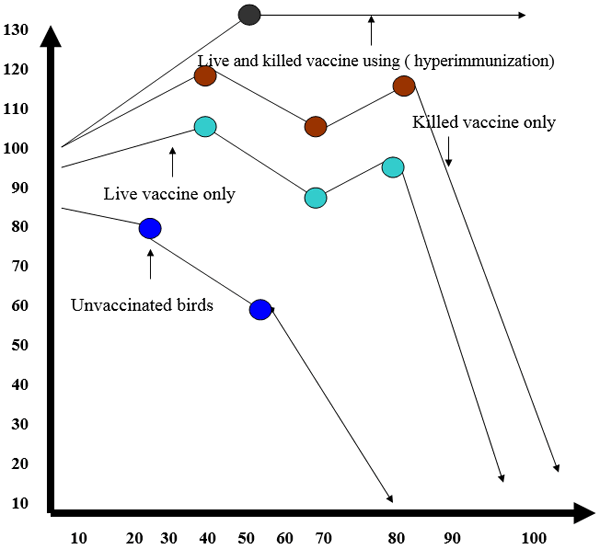
Using of killed and live vaccine to induce hyperimmunizatiom
Related topics
Authors:
Influencers who recommended :
Mohammed kassemJoin to be able to comment.
Once you join Engormix, you will be able to participate in all content and forums.
* Required information
Would you like to discuss another topic? Create a new post to engage with experts in the community.
Create a post27 de enero de 2014
but if there is aproblem of N.D I SUGGEST NOT TO VACCINATE AND GIVE immunostimulant drugs as i refer to my article you can go to it
if you need my programmes for layes i will give you
in the last this is my field experience of view about my vaccination programe which can be suitable in area and not siutable in other area of the world
thank you
27 de enero de 2014
dear ninad
im very pleased for your comment on my article
as you know the very strong waves of vesrotropic form of N.D viruses affect our area of the middle east and india and alot of country along the world and there is alot of vaccination belonging to many companies but with no sufficient value
so we make some programmes in my area which gives some good resultin broiler as
at 7 days vaccinate in water with hitchener beside I.B and in 10 days you inject killed vaccine belonging to N.D to give hyperimmunization to flock but you must give the dose according to the company required as it called (killed vaccine is dose related) to give good result and in 18 days you must give vitapest or avinew or lassota gold but through eye drop ( this technique is very important not through water intake and this is the last vaccination against newacastle
28 de diciembre de 2013
dear sir
you are right as there is arule refers thet in vitro not like in vivo as most of vaccination occur in vitro and most of signs occur in lab so dont depends on vaccination at all but you must depends on it beside your concentration on the immune system of the bird and how to build it good from the earilar stages of chicks as there is afact say the bird of the same weigt at the same age of 7 d will be of good immune system so you must increase your concentration on how to feed chick good in the first 7 days and give them aplenty of feed and go away from any stress during this perod and give the bird good rearing of vitamines and treat well mycotoxins problems early as possible as you can
in last the immune system of bird not stone but it is ameat and tissue
so you must built it good you must consider good hygenic biosecurity also
28 de diciembre de 2013
Field observations suggest that currently available vaccines and in practice vaccination programmes are unable to prevent field outbreaks. What is your experience?
29 de agosto de 2019
Thanks for your worthy informative article about Newcastle disease...
What's your opinion about adminstration of live n.d vaccine at 7day-old broiler while you suggest that maternally derived antibody will be 2^6 ??
26 de enero de 2014
Dear, Let me introduce first I Dr Ninad Mokal employee at Prabhat Poultry Pvt Ltd.
being a Veterinary Pathologist, the information that were you provided is very very usuful for prevention & control of N.d Disease. Etio Pathogenesis of the same well elaborated with adequate photographs.
The article is provided complite information of the Newcastle disease.If possible can you suggest line preventive measures & line treatment measures taken . Thanks for your needful Information.
Rgds,
Ninad Moakal
drninad_pathol@yahoo.co.in
drninadmokal@gmail.com
cell +91 9260357737
+ 31 7769080442













.jpg&w=3840&q=75)